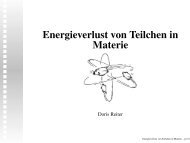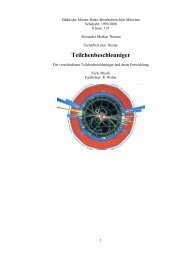The FEE Server Control Engine of the ALICE-TRD - Westfälische ...
The FEE Server Control Engine of the ALICE-TRD - Westfälische ...
The FEE Server Control Engine of the ALICE-TRD - Westfälische ...
You also want an ePaper? Increase the reach of your titles
YUMPU automatically turns print PDFs into web optimized ePapers that Google loves.
4.1.2 Readout Chamber Design<br />
108.16<br />
frame between<br />
pads and wires<br />
37 23.16<br />
48<br />
24<br />
Al ledge<br />
G10 ledge<br />
6<br />
wire ledge<br />
honeycomb<br />
4 <strong>The</strong> <strong>ALICE</strong> Transition Radiation Detector<br />
readout sandwich<br />
ampli�cation region<br />
12<br />
drift region<br />
radiator<br />
carbon fibre<br />
planes<br />
pad plane<br />
wire planes<br />
x<br />
y<br />
anode<br />
wires<br />
cathode<br />
wires<br />
x<br />
100<br />
75<br />
50<br />
25<br />
0<br />
2<br />
y<br />
4<br />
6<br />
8<br />
10<br />
12<br />
Time binSignal<br />
14<br />
cathode pads<br />
3<br />
Pad number<br />
1 2 3 4 5 6 7 8<br />
4<br />
Radiator<br />
electron<br />
5<br />
Drift<br />
Chamber<br />
electron<br />
amplification<br />
region<br />
Figure 4.2: Right: Cross-section <strong>of</strong> a <strong>TRD</strong> chamber ([Mah04]). Left: An electron is passing <strong>the</strong><br />
chamber and leaves a track <strong>of</strong> ionized particles. Embedded is <strong>the</strong> resulting signal on<br />
<strong>the</strong> cathode pads [<strong>TRD</strong>01].<br />
<strong>The</strong> <strong>TRD</strong> readout chamber can be divided into four parts (see figure 4.2): radiator, drift<br />
region, amplification region and <strong>the</strong> readout section.<br />
In <strong>the</strong> radiator charged particles with a large γ factor create transition radiation. To<br />
achieve a good radiation yield a large number <strong>of</strong> boundaries in <strong>the</strong> radiator is needed.<br />
In case <strong>of</strong> <strong>the</strong> <strong>TRD</strong> a fibre mat radiator was chosen. <strong>The</strong> main radiator material are<br />
polypropylene fiber mats whereas <strong>the</strong> covers and <strong>the</strong> walls <strong>of</strong> <strong>the</strong> radiator are made out<br />
<strong>of</strong> Rohacell HF71 foam reinforced by glass fiber sheets. To increase <strong>the</strong> mechanical stability<br />
not <strong>the</strong> complete volume <strong>of</strong> <strong>the</strong> radiator is filled with <strong>the</strong> fiber mats. <strong>The</strong> top and<br />
bottom covers <strong>of</strong> <strong>the</strong> radiator are connected with 8 mm Rohacell plates which form a grid<br />
like structure. <strong>The</strong> fields <strong>of</strong> <strong>the</strong> grid are filled with <strong>the</strong> polypropylene fiber mats. Fortunately<br />
also <strong>the</strong> Rohacell is a quite good radiator material so that <strong>the</strong> dead material inside<br />
<strong>the</strong> radiator is minimized. Figure 4.3 shows <strong>the</strong> microscopic structure <strong>of</strong> <strong>the</strong> Rohacell<br />
and <strong>the</strong> fiber mats. One can see clearly <strong>the</strong> huge amount <strong>of</strong> boundary layers which are<br />
essential for a high transition radiation yield.<br />
Usually one uses a stack <strong>of</strong> tense foils as a radiator (foil radiator) due to <strong>the</strong> better<br />
transition radiation yield compared to a fibre mat radiator. In case <strong>of</strong> <strong>TRD</strong> this was not<br />
possible because <strong>the</strong> space frame structure needed for <strong>the</strong> tense foils would add too much<br />
inactive material which decreases <strong>the</strong> efficiency <strong>of</strong> <strong>the</strong> <strong>TRD</strong> and would affect <strong>the</strong> detectors<br />
outside <strong>the</strong> <strong>TRD</strong>, too. Secondly <strong>the</strong> radiator should add as much as possible to <strong>the</strong><br />
mechanical stability <strong>of</strong> <strong>the</strong> chamber.<br />
Directly at <strong>the</strong> top <strong>of</strong> <strong>the</strong> radiator a 25 µm aluminized Mylar foil is glued. This foil is<br />
<strong>the</strong> entrance window to <strong>the</strong> drift region <strong>of</strong> <strong>the</strong> chamber. <strong>The</strong> Mylar foil is biased with a<br />
negative potential <strong>of</strong> -2.1 kV whereas <strong>the</strong> cathode wires which separate <strong>the</strong> drift region<br />
from <strong>the</strong> amplification region are at ground potential. <strong>The</strong> drift and <strong>the</strong> amplification<br />
region are filled with a gas mixture <strong>of</strong> 85% xenon and 15% CO2.<br />
drift<br />
region<br />
25







